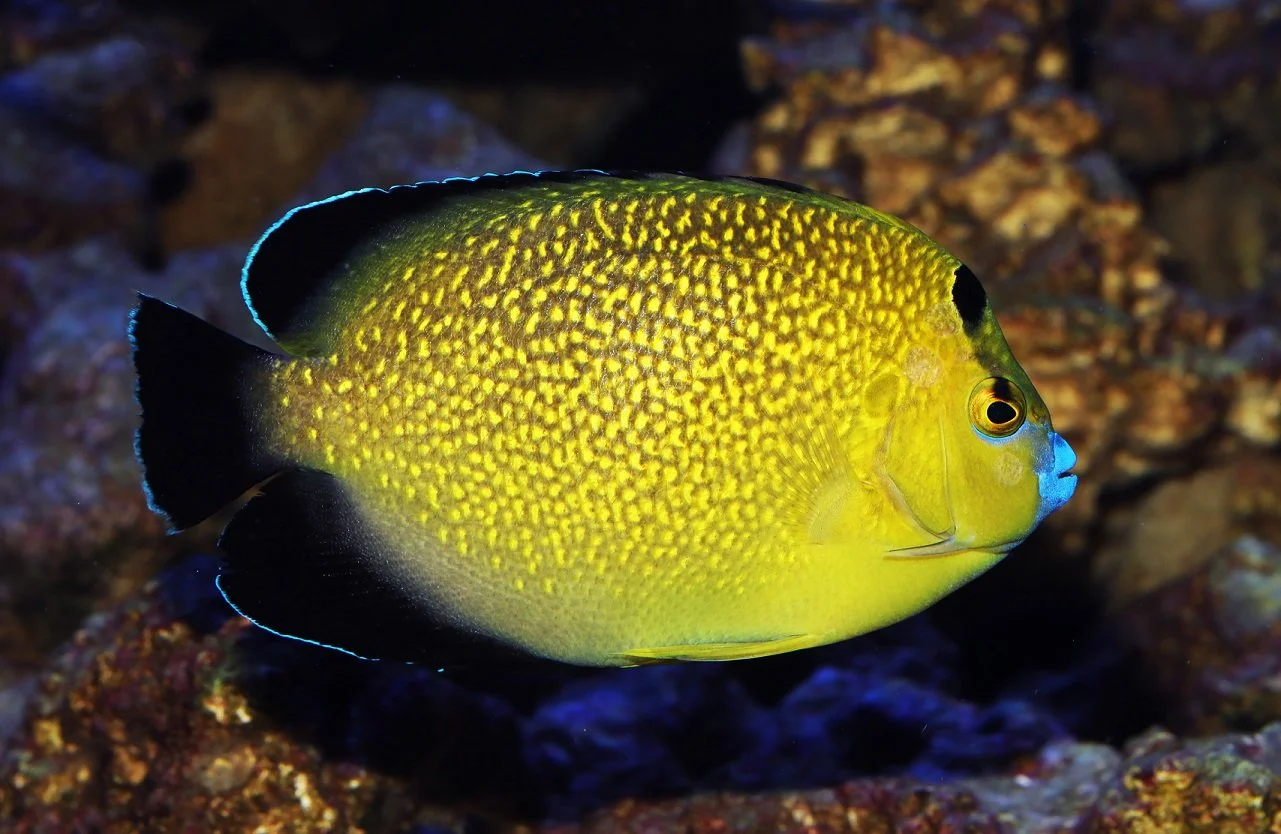 Image 1 of 1
Image 1 of 1


Goldflake Angelfish - 6-7"
The Goldflake Angelfish, also known as the Yellowspotted Angelfish and the Map Angelfish, and scientifically known as Apolemichthys xanthopunctatus, is a stunning marine species that captivates saltwater aquarium enthusiasts with its vibrant appearance. Characterized by a bright purple or blue mouth, black fins, and striking electric blue trimming, this angelfish exhibits dramatic changes in coloration as it matures from juvenile to adult. Due to its aggressive tendencies toward other angelfish, it is best kept alone or with larger fish that can hold their own.
Native to the coral reefs of the Indo-Pacific region, the Goldflake Angelfish thrives in coral-rich areas, lagoons, and reef slopes. In the wild, they seek shelter among crevices and caves within the coral formations, making it essential to replicate these conditions in captivity for their well-being.
While the Goldflake Angelfish makes a beautiful addition to any aquarium, it is not considered reef safe. It has a tendency to nip at soft and stony corals, which can harm your reef ecosystem. Careful monitoring and consideration are necessary when introducing this species to a reef environment.
This moderately sized angelfish typically reaches lengths of up to 7 inches (18 centimeters) and can live for 10 to 15 years or more in captivity, making it a rewarding, long-term addition to your aquarium.
Providing a balanced diet is crucial for the Goldflake Angelfish's health. Their diet should include a mix of high-quality marine pellets, frozen foods such as mysis and brine shrimp, and live or fresh marine algae, like seaweed sheets. Incorporating sponge-based foods can also help meet their dietary needs.
This species can be territorial and aggressive, especially toward other angelfish. It's advisable to house them individually or as a mated pair. Potential tankmates that may coexist peacefully include larger tangs, butterflyfish, wrasses, triggerfish, and select damselfish.
Goldflake Angelfish do not exhibit significant sexual dimorphism, making it challenging to differentiate between males and females visually.
Juvenile Goldflake Angelfish are known for their vibrant yellow bodies adorned with striking blue spots. As they mature, their coloration transforms into a predominantly yellow body with intricate golden reticulated patterns.
To provide the best environment for your Goldflake Angelfish, adhere to the following guidelines:
Minimum Aquarium Size: 120 gallons for a single fish; larger tanks provide more swimming space.
Decor and Hiding Places: Incorporate live rock structures, caves, and overhangs to mimic their natural habitat.
Water Conditions:
pH: 8.1 to 8.4
Salinity: 1.020 to 1.025
Temperature: 74°F to 78°F (23°C to 26°C)
Water Flow: Moderate to strong flow to emulate natural reef conditions.
The Goldflake Angelfish, also known as the Yellowspotted Angelfish and the Map Angelfish, and scientifically known as Apolemichthys xanthopunctatus, is a stunning marine species that captivates saltwater aquarium enthusiasts with its vibrant appearance. Characterized by a bright purple or blue mouth, black fins, and striking electric blue trimming, this angelfish exhibits dramatic changes in coloration as it matures from juvenile to adult. Due to its aggressive tendencies toward other angelfish, it is best kept alone or with larger fish that can hold their own.
Native to the coral reefs of the Indo-Pacific region, the Goldflake Angelfish thrives in coral-rich areas, lagoons, and reef slopes. In the wild, they seek shelter among crevices and caves within the coral formations, making it essential to replicate these conditions in captivity for their well-being.
While the Goldflake Angelfish makes a beautiful addition to any aquarium, it is not considered reef safe. It has a tendency to nip at soft and stony corals, which can harm your reef ecosystem. Careful monitoring and consideration are necessary when introducing this species to a reef environment.
This moderately sized angelfish typically reaches lengths of up to 7 inches (18 centimeters) and can live for 10 to 15 years or more in captivity, making it a rewarding, long-term addition to your aquarium.
Providing a balanced diet is crucial for the Goldflake Angelfish's health. Their diet should include a mix of high-quality marine pellets, frozen foods such as mysis and brine shrimp, and live or fresh marine algae, like seaweed sheets. Incorporating sponge-based foods can also help meet their dietary needs.
This species can be territorial and aggressive, especially toward other angelfish. It's advisable to house them individually or as a mated pair. Potential tankmates that may coexist peacefully include larger tangs, butterflyfish, wrasses, triggerfish, and select damselfish.
Goldflake Angelfish do not exhibit significant sexual dimorphism, making it challenging to differentiate between males and females visually.
Juvenile Goldflake Angelfish are known for their vibrant yellow bodies adorned with striking blue spots. As they mature, their coloration transforms into a predominantly yellow body with intricate golden reticulated patterns.
To provide the best environment for your Goldflake Angelfish, adhere to the following guidelines:
Minimum Aquarium Size: 120 gallons for a single fish; larger tanks provide more swimming space.
Decor and Hiding Places: Incorporate live rock structures, caves, and overhangs to mimic their natural habitat.
Water Conditions:
pH: 8.1 to 8.4
Salinity: 1.020 to 1.025
Temperature: 74°F to 78°F (23°C to 26°C)
Water Flow: Moderate to strong flow to emulate natural reef conditions.